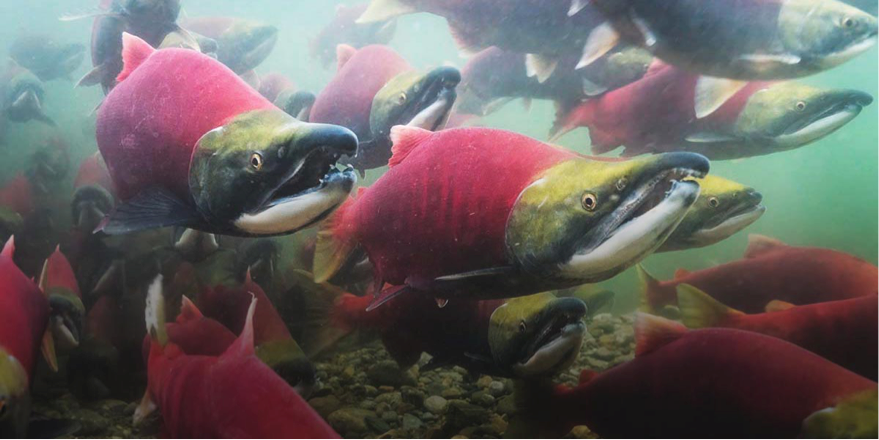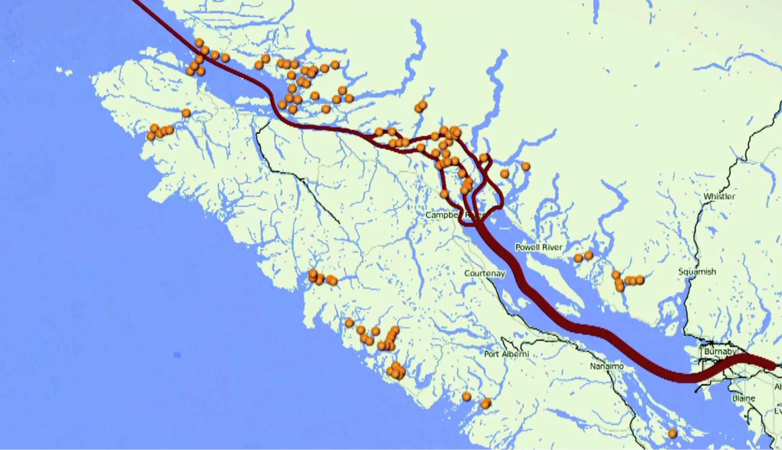Salmon Confidential is a documentary released in 2013, both written and directed by Twyla Roscovich. It was received with mixed reactions and given a 7.6 rating on IMBD (“Salmon Confidential (2013) - IMDb,” n.d.). The film followed biologist Alexandra Morton as she traveled throughout British Columbia (BC), hoping to solve the issue as to why there had been such a drastic decline in wild salmon in the province. Morton discovered that large quantities of wild salmon in BC were dying and also testing positive for dangerous European viruses such as Infectious Salmon Anemia (ISA), Salmon Alpha Virus, and Piscine Reovirus. The root cause of salmon infestation seemed to be the proliferation of salmon farms throughout BC Fraser River and its tributaries. The decline in the wild salmon first began occurring in the 1990s, when a sudden drop in the quantity of the wild salmon was observed. The video showed that not only was there a large number of salmon contracting the viruses and dying, but that the Canadian government seemed to be turning a blind eye to the issue, treating the salmon deaths as natural.

Sockeye Salmon (image 1)
Source: Raincoast Conservation Foundation
The sockeye salmon is a keystone species—it is crucial to the life of animals and Indigenous peoples in BC (Roscovich, 2013). They provide food and help maintain the traditions of the local Indigenous people. However, economic and political factors threatened wildlife and the culture of Indigenous peoples, as highlighted by the documentary.
Wild sockeye salmon migrate every year and they pass many fish farms along Fraser River in BC as part of their migration route (see image 2). According to the documentary, many wild sockeye salmon were dying because they were contaminated by the diseases coming from farmed fish. Farmed fish conduct diseases and have the ability to continue living due to lack of predators in their environment (Roscovich, 2013). Farmed fish were messing up natural laws and threatening the existence of the wild sockeye salmon.

Source: Planetsave
Salmon Confidential revealed that there was a great deal of politics surrounding the death of millions of sockeye salmon. Many actors were involved such as the government, environmentalists, scientists, the Indigenous peoples of BC, salmon farm companies, and the market. The government and the salmon companies wanted to continue to supply the market with their farmed fish and make a profit. Environmentalists had to fight against these actors in order to preserve the valuable sockeye salmon. The Indigenous people in BC were also harmed as they are highly dependent on the salmon to maintain their culture and traditions. There was evidence and confirmation from several scientists that the ISA disease was killing the salmon in BC, but the Canadian government continued to ignore the facts, concealed the truth from the public, and intimidated the scientists (Roscovich, 2013). The government alleged that the reason for the death of millions of fish was ‘overfishing’ and ‘water scarcity’. The government turned this issue into a federal secret in order to protect their markets and trade agreements (Roscovich, 2013).
According to politicians, admitting there were diseases that were killing the sockeye salmon would kill the salmon farm industry and ruin the image of Canada. The Canadian government was trying to preserve the image of Canada as strong, independent and healthy. Canada is seen as a country that is rich in water (Nayak, 2018), but if this water is contaminated with sick fish, the value of water is diminished and therefore the image of the country’s wealth is also denigrated. As could be inferred from the documentary, the government gave more importance to economics rather than on Canada’s wildlife and the Indigenous peoples of BC.
In line with the documentary, the INDEV class also discussed the politics around land, water and energy. These resources are important because they are basic necessities and are a human right (Nayak, 2018). The fact that these resources are critical for human survival make them a target of politics, power imbalance, and inequality, often leaving the poor and marginalised on the losing end. A parallel example to the sockeye salmon issue is the story of a large mining or industrial company releasing effluents and polluting the river. The negative impact of pollution is magnified for a downstream village that depends on the river for food, water, livelihood, religious rituals, etc. The government turns a blind eye to the negative impact of pollution because it prioritizes economics i.e., tax revenues from the company and economic development, as more important than the life of the village and the river.
The documentary concluded that although the government needed to take action to address the issue, it was also the public’s responsibility to be involved. Local environmental stewardship is needed to protect the sockeye salmon population. Training people to identify sick fish and to keep an eye on the environment, as well as reducing consumption of farmed salmon were proposed as some of the solutions to reduce the threat to the wild sockeye salmon population in British Columbia.
References:
Nayak, P. (2018). Politics around Land, Water and Energy [Lecture notes].
Roscovich, T. (Director). (2013, October 2). Salmon Confidential [Video file]. Retrieved January 15, 2018, from Atlantic Salmon Federation